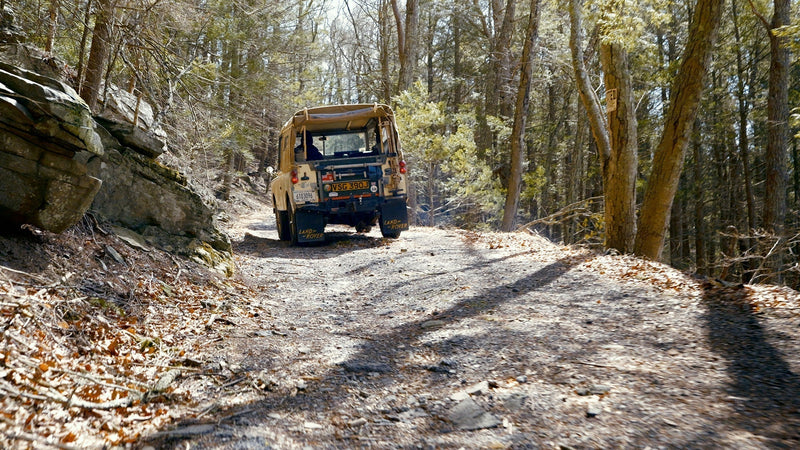After three weeks spent in Cuba, I took a hop over to Mexico and enjoyed a week on the Rivieira Maya in Playa del Carmen, Tulum, and Bacalar, before heading to Mahahual, a small fishing village on the Caribbean coast. Located in the state of Quintana Roo, it is well known for the beaches’ close proximity to the coral reef, and of course the resulting sea life that makes the spot ideal for snorkeling. I went there to swim with some turtles, a lovely experience that I would recommend for everyone, but I found else something old and green that I thought Petrolicious readers might be more interested in.





I stayed at la Casa de la Langosta, owned by a man named Mike who cooks a mean lobster and offers guests a wonderfully beach-idyllic campsite with plenty of parking for the various traveling vans and 4x4s that make their way to the shore.
It was in this relaxing, creative creative environment (while I was there some friends were painting Mike’s house for instance), that I met a couple living in a Volkswagen: Israel, from Mexico, and Jen, from Germany. They are traveling in Mexico with this piece of pretty patina, and it took them about three months to refurbish it to make it ready for their trek. The second day after I arrived, I asked them if I could do a photoshoot of the whole “family," and they were kind enough to set it all up and share their lives with me.




The scene was perfect, postcard-like, and I had to take the time for a quick sketch in my notebook. Palm trees and hammock swaying in the breeze, the dappled light through the leaves hitting the warm sand, and of course the assortment of vehicles owned by this intriguing couple. It includes the palm trees, the beach, hammock, and their collection of vehicles. There’s a great deal of continuity between their T2 van, motorcycle, and bicycle, something that can only come from handcrafting. They might look a little rough, but it’s all by design.





Israel and Jen love quality vintage pieces, whether it’s a belt buckle or a Volkswagen, and you can see their collective eye for detail with just a few glances at what they’ve built here. The Carabela motorcycle with all the belts, the helmet, the satchels and other accessories, that was the masterpiece for me. The bicycle was following the same style, what with the metal water bottle and air pump attached and aged to match the rest of the bike’s look.






And what a look. If the patina looks just a bit too perfect you’d be right in thinking it’s not real. I can see people getting all up in arms about this, this “authenticity,” but let’s just think about it for a moment: what’s inauthentic here? Yeah, the rust is painted on by hand rather than a product of age mixed with moisture, but there are no airs being put on here, they aren’t pretending the thing’s been through the gauntlet and back. It’s certainly not a rusty ratted-out T2, so think of it as an art project, which, in addition to being a place to live out of, it is.




I actually saw Israel painting a section of the van on the the first day I met him, and besides my admiration of his craftsmanship, it prompted me to think on the age-old automotive adage that it’s better to build it than buy it. So where does Israel’s van fall on that spectrum? There’s an obvious conundrum here: the patina is “fake,” but he’s turned a regular old T2 into this beautiful work of art with is own two hands. It’s just earning patina in a different way than you’d normally do it, if you ask me. Is it technically patina? No. Does it matter? Probably to somebody, but if that puts you off from this project then I’m sorry you’re such a bore at parties.









After admiring the details on the exterior Jen invited me in to see how the work carried into the interior. A thorough job throughout, what struck me first was the lovely wooden slats on the roof. It was like being in a beach bungalow that happened to have an engine under it. The fabric for the seats was coordinated throughout the rest of the van, all the way to the toothbrush holders! The silverware set, first aid kit, blanket, everything was carefully thought out and chosen for its purpose, but also for its aesthetic. For those wondering about the seeming randomness of the scale model on the dash, the Fiat 1100 is the car that Israel owned prior to the Volkswagen—it lives on in memory and in diecast now.


I met Israel and Jen by circumstance a few months later in Puebla, me just passing through and them having decided to use the place as a hub for local exploring. I wish them luck, they do the same to me, and we part ways again. It’s left a good taste in my mouth, seeing these lively, fun, down-to-earth people doing something not only adventurous, but simultaneously artistic. Built not bought, what about painted, not rusted?





Jen is working as a freelance translator and interpreter, and Israel buys, repairs, and sells vintage pieces, mostly bicycles and motorcycles or their related gear. They are called The Rolling Vintage, and they also make leather bags for travelers like them. You can follow them on Instagram




















































